All your variables have a slice type. Slices have a backing array. In Go you can't access uninitialized variables. If you don't explicitly provide a value when you create a new variable, they will be initialized with the zero value of the variable's type.
This means when you create a slice with make([]int, 0, 5), it also creates a backing array, the backing array will be initialized with its zero value, and this zeroed array will be sliced. The zero value of an array type is an array having the zero value of element type for each of its elements.
So even though you didn't explicitly set every elements of the backing array to 0, they will be zeroed automatically. So when you do c := b[:2], it will slice the b slice, and c will have a length of 2, and those 2 elements will be 0.
And when you do d := c[2:5] that slices the c slice, its length will be 5-2 = 3, and its capacity will also be 5-2 = 3 because slicing a slice will result in a new slice which shares the same backing array, and the capacity will be the first element till the last of the backing array (unless you use a full slice expression which also controls the resulting slice's capacity).
Must-read blog posts for newcomers who want to understand slices and arrays:
The Go Blog: Go Slices: usage and internals
The Go Blog: Arrays, slices (and strings): The mechanics of 'append'
